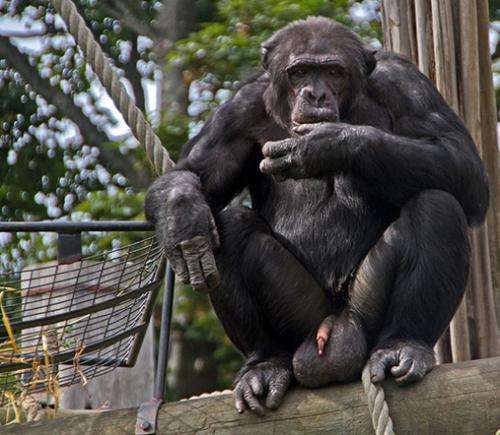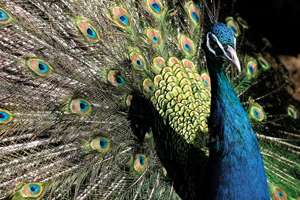Large testicles are linked to infidelity

There is a clear correlation between the size of the testicles of male primates and the proneness to infidelity of females. Learn more about sex, sperm and infidelity at the anniversary exhibition Sexus.
"We can be grateful to parasites, bacteria and viruses for our ability to have sex. Even though sexual reproduction is far less efficient than non-sexual, nearly all living organisms that you can observe in your environment are based on sexual reproduction. The most important function of sex is to reshuffle the genes in each mating. In this way, the immune system develops resistance to parasites, bacteria and viruses," explains Petter Bøckman, Assistant Professor, who has helped produce the new anniversary exhibition Sexus at the Natural History Museum, University of Oslo, Norway.
The correlations between evolution and sperm, infidelity and sex will be a key element of Sexus, which will open in mid-February – and stay open for the entire year – to celebrate the museum's bicentennial.
"Gender is perhaps the most decisive element of our understanding of self in our lives. It is thus important to understand why we are male and female and what this has meant for evolution."
Sexual selection
Charles Darwin (1809–1882) is primarily known for his theory of evolution about 'the survival of the fittest', which is often translated as 'natural selection'. At the time, the theory attracted huge attention.
"Darwin's other theory, which did not attract the same amount of attention although it was a lot more revolutionary, was his theory of sexual selection. While natural selection was a concept that was easily acceptable in the Victorian era, a theory of selection with the aid of sex was far more controversial. With sexual selection, evolution proceeds faster than with natural selection."
Natural selection promotes a special type of characteristics that are not very costly. An animal possesses only a limited amount of resources.
"Natural selection favours small, cheap characteristics. This notwithstanding, the world is full of resplendent characteristics."
Darwin noticed the peacock's tail. It is enormously large and shimmering in a metallic turquoise with metallic-blue eye-shaped patches. Male peacocks use their tail to compete for the attention of females.
"It is not easy to fly with a tail which is five feet long. The life of a peacock is a never-ending obstacle race among snakes and jungle cats. With natural selection, such a thing as the peacock's tail should not be possible. Nevertheless, the peacock has developed this sexual trait."
Darwin launched his theory of sexual selection, but was never able to demonstrate it.
An explanation was not found until after the Second World War, when the British geneticist Angus John Bateman (1919‒1996), who conducted research on fruit flies, found mathematical evidence for the theory of sexual selection.
By using large and visible mutations he could demonstrate who were the mothers and fathers of each cohort.
"The number of offspring of a female remains fairly constant. When she has mated once, she has received enough sperm to fertilize all her eggs. The male, on the other hand, is restricted by the number of females he can catch. The female has limited resources and is therefore more selective in her choice of partners than males are."
Seducers with large antlers
Examples of characteristics that are promoted by sexual selection include the antlers of elk, deer and red deer.
"The antlers provide the females with an opportunity to assess the quality of the male's genes. A healthy male elk can have antlers that are ten to twenty times larger than those of a bull who is in bad shape. It's easy to spot the difference between bike-handle antlers and a huge set of shovels. In order to carry the largest antlers, the male must be in extraordinarily good shape. The females therefore select the bulls that have the largest antlers. All bulls can survive with small antlers. These gendered features are costly, since the bulls must have sufficient resources to develop them. These sexual traits are thus extremely variable," Bøckman points out.
In most species, the females make the largest sacrifice and will thus be the ones to choose a mate. Sometimes, however, it is the other way round.
"In seahorses, the male takes care of pregnancy. The female lays her eggs with the male. The female seahorse is large and colourful. The male is unassuming and grey and chooses a partner. The male has the onerous task of looking after the offspring."
This applies also to jacana birds, a tropical family of waders. Here too, the male chooses the female and he will be the one to look after the eggs. He will therefore shop around for the best female, who can provide him with the best possible conditions while he is tending to the nest.
"Sexual selection is therefore often a matter of who will lose most. In some species, both genders make the same effort, and the male and female will then often be identical. Mainly, however, the female must make the largest sacrifice. Therefore, the female must normally choose the best possible partner.
Even in humans, the selection pressure is harder for men than for women.

Most women have children. Some men can have an inordinate number of offspring. Many men have none. In the Stone Age, six out of ten men never had any children.
"This is equal to more than half the population in each generation. Sexual selection thus exerts a powerful evolutionary pressure. No wonder that sexual selection can proceed at a much faster pace than natural selection."
For a female, it can be beneficial to have more than one father to a litter of offspring. Even though a male may look big and healthy, his genes may not be optimal under all conditions. Having a variety of genes may be beneficial in order to spread the risk a little.
"If you have all your children with one man, influenza may kill all of them. However, if you mate with the neighbouring male as well, perhaps only some of the children will perish."
A battle of sperm after mating
Sexual selection continues after mating. All males want their semen to win the race.
In many species, the male makes sure that no other males can mate with the female. Some male insects will not let go of the female. He remains firmly stuck. Some males are disposable. Even though the male dies immediately after mating, his sexual organ falls off and remains inside the female.
Even among rodents, the male can plug up the female after mating, The last squirt of semen hardens and plugs up the lady for the rest of the mating season.
Female squirrels have found a solution to this. When the male has finished, she removes the plug. The better she is at removing it, the firmer the male's plug needs to be.
Some males have a penis with a built-in sperm scraper. The penis can thus grab hold of the previous suitor's sperm and scrape it out.
The female has also an opportunity to filter out those who will be permitted fatherhood, for example by having an orgasm. In some animal species, the females need fairly powerful stimulation to reach orgasm. The sperm scraper on the male's penis functions as a knotty condom.
The orgasm functions as a filtering mechanism in humans as well.
"The orgasm demonstrates that the woman has found a man in whom she is genetically interested."
Huge testicles = infidelity
In primates, there is a correlation between infidelity and the size of the testicles.
"Here we can determine the degree of fidelity in the female by looking at the size of the male's testicles. The less faithful the female, the larger the male's testicles."
If the male will only fertilize one female and has no competitors, he only needs sufficient sperm to reach the egg. If the female mates on the side, it is smart to have as many cars as possible in the race. Then, the male must have testicles that are as large as possible.
"Bonobos in particular have huge testicles. They mate with everybody. There is an abundant flow of semen. Those who leave the greatest amount of sperm have the largest chance of fathering offspring. In gorilla troops there is only one male. Even though the gorilla has a small harem, he has no need for large testicles – his balls are tiny."
Having testicles that are too large is no advantage, however, since it increases the risk of testicular cancer.
"Animals with short lifespans may have enormously large testicles. In one type of grasshopper the testicles occupy half their body mass."
The testicles are even larger in sea urchins. They spawn directly into the ocean. To increase the chance of fertilizing an egg, the sea urchin is a huge testicle with a little shell around it.
The testicles of humans are one and a half times larger than those of gorillas.
"This testifies with abundant clarity to life in our flock. We can pledge our fidelity until we are blue in the face, but this is evidence that our females are cheating. We are not like chimpanzees, where the female has four or five sexual partners every time she is in heat, but there is always a certain likelihood that the neighbouring male has dropped by."
The testicles are also large in animals that have many females.
"Male lions have huge balls. All the females in the pride must have sex at the same time. When the female lions in the pride are in heat, he must mate with all the females every half hour for three days."
Enough sperm for all
"We males have an incredible amount of sperm. We can just go on spreading it."
Each day, all the men on Earth combined produce an amount of semen equal to the volume of water in Norway's largest river, the Glomma. In contrast, the total volume of eggs produced by all the world's women combined amounts to only two decilitres, despite the fact that the eggs are one million times larger than the sperm cells.
The constant production of sperm is a strain on the organism. Unfortunately, testosterone also weakens the immune system, thus reducing life expectancy.
"This means that you need to be in rude health to be able to sustain a high testosterone level, and testosterone has an effect on the masculine features that you develop."
The brain is our peacock's tail
While salamanders and butterflies engage in fantastic courtship dances and cranes hoot to each other before mating, human courtship looks like an incredibly boring affair.
"It looks as though we are breathing at each other for hours on end. What we in fact are doing is to check out how intellectually stimulating our potential partner is. We check out each other's brains by chatting."
Despite using twenty per cent of our energy metabolism, our brain accounts for only 1.5 per cent of our bodyweight.
"In humans, intelligence is the most variable feature. A man with a well-functioning immune system can physiologically afford high intelligence and good sperm quality. One question we are asking at the exhibition is whether the brain is an organ for sexual selection, like the peacock's tail. The idea is that people functioned well also in earlier times, even though their brains were only half as big. This notwithstanding, our brain has kept growing. Thus, the growth of the brain is not driven by survival, but by something else. And this is where the apparently boring suddenly becomes meaningful. Just as the elk measures the size of antlers, we humans measure each other's brains before we mate," explains Petter Bøckman.
Provided by University of Oslo



















